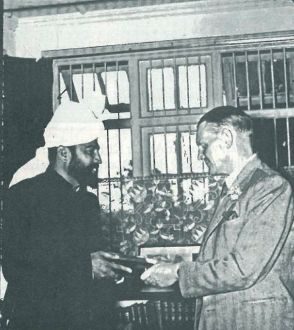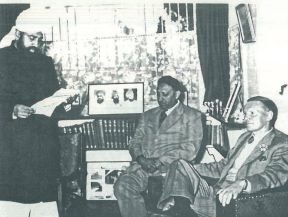Awwab Saad Hayat, Al Hakam

Sheikh Mubarak Ahmad Sahib, while serving as a missionary for the Jamaat, attained the honour of continuing to discharge his responsibilities until the age of 81. Achieving success in continuous service for a period of 60 years is itself an honour and a special blessing, and it is possible only by Allah’s grace.
Sheikh Mubarak Ahmad Sahib was born in 1910 in the region of Punjab, in the house of a companion of Hazrat Sheikh Muhammad Dinra. In 1931, when he was 21 years old, after completing his studies, he stepped into the field of service, and this series of services continued until the age of 81. After acquiring education and basic training, he achieved remarkable success in his service of Islam. His service continued in various areas of British India. His first posting was in Lyallpur city (now Faisalabad, Pakistan). Then, under the supervision of Hazrat Khalifatul Masih IIra, his assignment of responsibilities spanned the entire Indian subcontinent.
After leaving the subcontinent, new horizons awaited him.
At that time, the four East African countries under British colonial rule were Kenya, Uganda, Tanganyika (now part of Tanzania), and Zanzibar.
Just as in West Africa, where Hazrat Maulana Abdul Rahim Nayyarra and Hazrat Maulvi Nazir Ahmad Alira were among the first missionaries to set foot, similarly, in East Africa, the honour of being the initial missionary was granted to Maulana Sheikh Mubarak Ahmad Sahib.
The message of Ahmadiyyat reached the aforementioned countries of East Africa in 1896 when, at that time, some companions of the Promised Messiahas were given jobs in the construction and operation of the Uganda Railway project. However, the establishment of a permanent mission occurred with the arrival of the respected Maulana Sheikh Mubarak Ahmad. He departed from Qadian on 11 November 1934, and reached Nairobi on 27 November. For the next 28 years, he achieved success and blessings through a series of services and endeavours in the lands of Hazrat Bilalra.
During this period, he also witnessed the various ups and downs of this region. The events of gaining independence from British colonial rule and the partition of these nations all unfolded before him. Prior to their independence, he was entrusted with the missions in these four countries.
In his own written memoirs, he states: “From the headquarters, I was appointed as the Amir and Chief Missionary for the entire East Africa. In the last years, Aden was also included in my jurisdiction, and it was instructed that I should visit Aden every 15 days, and besides imparting congregational training, fulfil other responsibilities as well.” (Kaifiyat-e-Zindagi, p. 63)
During the years 1961-1962, when Kenya and Uganda gained independence and Tanganyika and Zanzibar merged to form Tanzania on the world map, individual Jamaat systems were implemented in these countries. Respected Maulana Sheikh Mubarak Ahmad Sahib was appointed as the Amir and Regional Missionary of Kenya alone, and after fulfilling these duties until 30 April 1962, he returned to Pakistan.
After the establishment of the mission in East Africa, his headquarters were located in the city of Nairobi, Kenya. The Ahmadiyya Mosque in Nairobi contained a small room with only a desk, which served as the entirety of his office space. All mission-related matters were concluded here, and all programmes were finalised in this space.
During this period, his famous debates with Lal Hussain Akhtar in East Africa became well-known, resulting in the inclusion of several sincere families into the fold of Ahmadiyyat. Similarly, the challenge he posed to the renowned American preacher Dr. Billy Graham and his subsequent evasion continued to make headlines in African newspapers.
Respected Sheikh Umri Ubaidi (former Minister of Justice, Tanzania), in November 1936, through the efforts of the esteemed Maulana Sheikh Mubarak Ahmad Sahib, took the bai‘at and joined the Ahmadiyya fold.
In East Africa, Maulana Sheikh Mubarak Ahmad Sahib was granted the opportunity to serve in various capacities. The construction of mission houses and mosques in Tabora and Dar-es-Salaam in Tanzania, Jinja and Kampala in Uganda, and Nairobi, Mombasa, and Kisumu in Kenya were all completed under his guidance and supervision. Furthermore, he also initiated the establishment of the first Majlis Khuddam-ul-Ahmadiyya in Nairobi in April 1938.
A significant achievement that became part of respected Sheikh Sahib’s legacy is the publication of the Swahili translation of the Holy Quran. Swahili is still one of the most widely spoken and understood languages in the world today, particularly in various parts of East Africa, and ranks among the top ten most spoken languages globally. The work on the Swahili translation of the Holy Quran began in November 1939, under the guidance of Hazrat Khalifatul Masih IIra, during the blessed month of Ramadan. This effort reached its completion milestone in March 1953. The preface to this translation of the Quran was personally penned by Hazrat Musleh-e-Maudra.
The publication of the Swahili translation of the Holy Quran marked a significant event, ushering in a new and golden era in the history of Islam Ahmadiyya in East Africa.
In addition to the Swahili translation of the Holy Quran, during the establishment of the Jamaat in Kenya, he was granted the opportunity to publish the Swahili translation of Hazrat Mirza Ghulam Ahmad’s book Kashti-e-Nuh, (Noah’s Ark).
In the realm of publications, a noteworthy accomplishment was his initiation of a monthly magazine in the Swahili language called Mapenzi Ya Mangu (Fruits of Love) in January 1936. The popularity of this magazine can be gauged from the fact that its first issue had a circulation of 1000 copies, which quickly rose to 2000 copies with the second issue. This magazine continued to be published for a considerable period, initially in Kenya and later in Tanzania.

Sheikh Sahib introduced a two-page newspaper named the East African Times. Initially, it was published as a monthly magazine, but later, due to increasing demands, it was expanded to a fortnightly publication. This newspaper is still being published in Kenya to this day.
Hence, his service in East Africa spanned 28 years, during which he achieved remarkable success. The events of this period are a significant part of the history of Ahmadiyyat, documented in the relevant volumes of the history of Ahmadiyyat.
Upon his return to Pakistan in 1962, he held important positions such as Deputy Nazir Islah-o-Irshad, Additional Nazir Islah-o-Irshad (Taleem al-Quran), Secretary Fazl-e-Umar Foundation, and Secretary Hadiqa-tul-Mubashireen. Furthermore, he managed the construction of the grand buildings of Masjid Aqsa Rabwah, Khilafat Library Rabwah, and Fazl-e-Umar Foundation Rabwah offices with great dedication and grace.
After rendering significant services for 13 years at the Rabwah, he was appointed as the Amir and Murabbi in charge of the UK in 1979. He continued his service in the UK until December 1983; during this time, he achieved notable success. Over these four years, he established new mission houses in nine different locations across the UK, including Oxford, Southall, Birmingham, Croydon, Manchester, Bradford, Huddersfield, Gillingham, and East London. Undoubtedly, this was an extraordinary achievement.
In 1983, he was appointed as the missionary-in-charge of the United States, where he served in this capacity for more than seven years. During this time, he achieved success by establishing mission houses at 13 different locations, and, by the grace of Allah, he was granted success in building five mosques.
The aforementioned glimpses shed light on the fact that Sheikh Sahib excelled in service wherever the opportunity arose, across the four continents of the world. His successful journey is marked by tireless effort, unwavering loyalty to the mission, prayers, trust in Allah, profound love and dedication to assigned tasks, unparalleled striving, and, above all, a strong connection and complete obedience to Khilafat-e-Ahmadiyya.
May Allah continue to grant new missionaries and preachers the opportunity to benefit from such great individuals, and may He continue to bless Ahmadiyyat with selfless missionaries until the Day of Judgement.
(In preparation for the above-mentioned materials, the content was extracted from the newspaper Al Fazl, 22 February 1992.)

